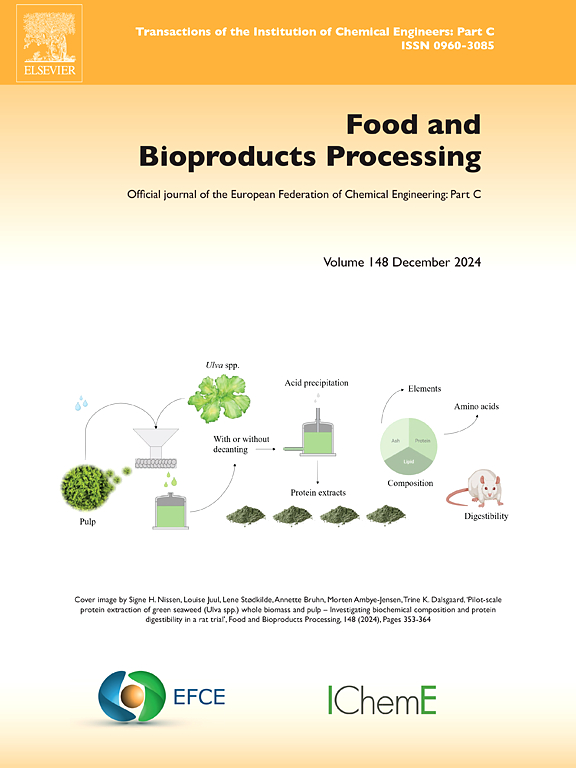通过即插即用微流控芯片制备鱼油微胶囊以增强稳定性和控制释放
IF 3.4
2区 农林科学
Q2 BIOTECHNOLOGY & APPLIED MICROBIOLOGY
引用次数: 0
摘要
鱼油面临着氧化、生物利用度低和感官性能差等挑战。虽然微胶囊化提高了稳定性,但传统方法存在单分散性差、岩心损坏和壁材控制有限的问题。在本研究中,即插即用微流体系统通过精确控制乳剂形成和绕过电荷匹配要求克服了这些限制。基于微流控技术,采用即插即用微流控芯片(单通道和三平行通道)控制鱼油微胶囊的制备(变异系数<; 5 %,壳厚163 ~ 592 μm,芯数1 ~ 5)和规模化生产。以海藻酸钠为网络骨架,整合阿拉伯胶(GA)的乳化稳定性和低甲氧基果胶(LM)的pH响应性,通过离子性交联构建了多维壁材筛选平台。结果表明,三元复合壁材体系(TCWMS)具有较低的过氧化值(POV)和丙二醛(MDA)值,以及较强的氢键作用。构建了多维壁材筛选平台和即插即用微流控芯片,实现了单分散油性微胶囊的稳定、可控的工业制备。本文章由计算机程序翻译,如有差异,请以英文原文为准。
Preparation of fish oil microcapsules for enhanced stability and controlled release via plug-and-play microfluidic chips
Fish oil faces challenges like oxidation, low bioavailability, and poor sensory properties. While microencapsulation improves stability, traditional methods suffer from poor monodispersity, core damage, and limited wall material control. In this study, the plug-and-play microfluidic system overcame these limitations by precisely controlling emulsion formation and bypassing charge-matching requirements. Based on microfluidic technology, a plug-and-play microfluidic chip (single-channel and three-parallel channel) was used to control preparation (coefficient of variation < 5 %, shell thickness from 163 to 592 μm, core number from 1 to 5) and scaled-up production of fish oil microcapsules. A multi-dimensional wall material screening platform was developed via ionotropic crosslinking, using sodium alginate as the network skeleton and integrating gum arabic (GA) for emulsifying stability and low-methoxyl pectin (LM) for pH responsiveness. The results showed that the ternary composite wall material system (TCWMS) exhibited lower peroxide value (POV) and Malondialdehyde (MDA) values, and strong hydrogen bonding interactions. The multi-dimensional wall material screening platform and plug-and-play microfluidic chip were built to enable stable, controllable industrial preparation of monodisperse oily microcapsules.
求助全文
通过发布文献求助,成功后即可免费获取论文全文。
去求助
来源期刊

Food and Bioproducts Processing
工程技术-工程:化工
CiteScore
9.70
自引率
4.30%
发文量
115
审稿时长
24 days
期刊介绍:
Official Journal of the European Federation of Chemical Engineering:
Part C
FBP aims to be the principal international journal for publication of high quality, original papers in the branches of engineering and science dedicated to the safe processing of biological products. It is the only journal to exploit the synergy between biotechnology, bioprocessing and food engineering.
Papers showing how research results can be used in engineering design, and accounts of experimental or theoretical research work bringing new perspectives to established principles, highlighting unsolved problems or indicating directions for future research, are particularly welcome. Contributions that deal with new developments in equipment or processes and that can be given quantitative expression are encouraged. The journal is especially interested in papers that extend the boundaries of food and bioproducts processing.
The journal has a strong emphasis on the interface between engineering and food or bioproducts. Papers that are not likely to be published are those:
• Primarily concerned with food formulation
• That use experimental design techniques to obtain response surfaces but gain little insight from them
• That are empirical and ignore established mechanistic models, e.g., empirical drying curves
• That are primarily concerned about sensory evaluation and colour
• Concern the extraction, encapsulation and/or antioxidant activity of a specific biological material without providing insight that could be applied to a similar but different material,
• Containing only chemical analyses of biological materials.
 求助内容:
求助内容: 应助结果提醒方式:
应助结果提醒方式:


